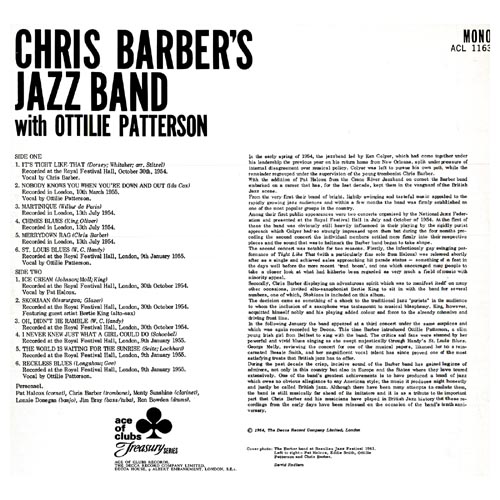| Chris Barber's Jazz Band with Ottilie Patterson (LP) | ||
 |
  |
|
 |
||
Sleeve Notes In the early spring of 1954, the jazzband led by Ken Colyer, which had come together under his leadership the previous year on his return home from New Orleans, split under pressure of internal disagreement over musical policy. Colyer was left to pursue his own path, while the remainder regrouped under the supervision of the young trombonist Chris Barber. With the addition of Pat Halcox from the Crane River Jazzband on cornet the Barber band embarked on a career that has, for the last decade, kept them in the vanguard of the British Jazz scene. From the very first their brand of bright, lightly swinging and tasteful music appealed to the rapidly growing jazz audiences and within a few months the band was firmly established as one of the most popular groups in the country. Among their first public appearances were two concerts organised by the National Jazz Federation and presented at the Royal Festival Hall in July and October of 1954. At the first of these the band was obviously still heavily influenced in their playing by the rigidly purist approach which Colyer had so strongly impressed upon them but during the four months preceding the second concert the individual members settled more firmly into their respective places and the sound that was to hallmark the Barber band began to take shape. The second concert was notable for two reasons. Firstly, the infectiously gay swinging performance of Tight Like That (with a particularly fine solo from Halcox) was released shortly after as a single and achieved sales approaching hit parade status — something of a feat in the days well before the more recent 'trad boom', and one which encouraged many people to take a closer look at what had hitherto been regarded as very much a field of music with minority appeal. Secondly, Chris Barber displaying an adventurous spirit which was to manifest itself on many other occasions, invited alto-saxophonist Bertie King to sit in with the band for several numbers, one of which, Skokiaan is included on this album. The decision came as something of a shock to the traditional jazz 'purists' in the audience to whom the inclusion of a saxophone was tantamount to musical blasphemy. King, however, acquitted himself nobly and his playing added colour and force to the already cohesive and driving front line. In the following January the band appeared at a third concert under the same auspices and which was again recorded by Decca. This time Barber introduced Ottilie Patterson, a slim young Irish girl from Belfast to sing with the band. The critics and fans were stunned by her powerful and vivid blues singing as she swept majestically through Handy's St. Louis Blues. George Melly, reviewing the concert for one of the musical papers, likened her to a reincarnated Bessie Smith, and her magnificent vocal talent has since proved one of the most satisfying treats that British jazz has to offer. During the past decade the crisp, incisive sound of the Barber band has gained legions of admirers, not only in this country but also in Europe and the States where they have toured extensively. One of the band's greatest achievements is to have produced a brand of jazz which owes no obvious allegiance to any American style; the music it produces might honestly and justly be called British jazz. Although there have been many attempts to emulate them, the band is still musically far ahead of its imitators and it is as a tribute to the important part that Chris Barber and his musicians have played in British Jazz history that these recordings from the early days have been reissued on the occasion of the band's tenth anniversary. |
||
| Cover page |